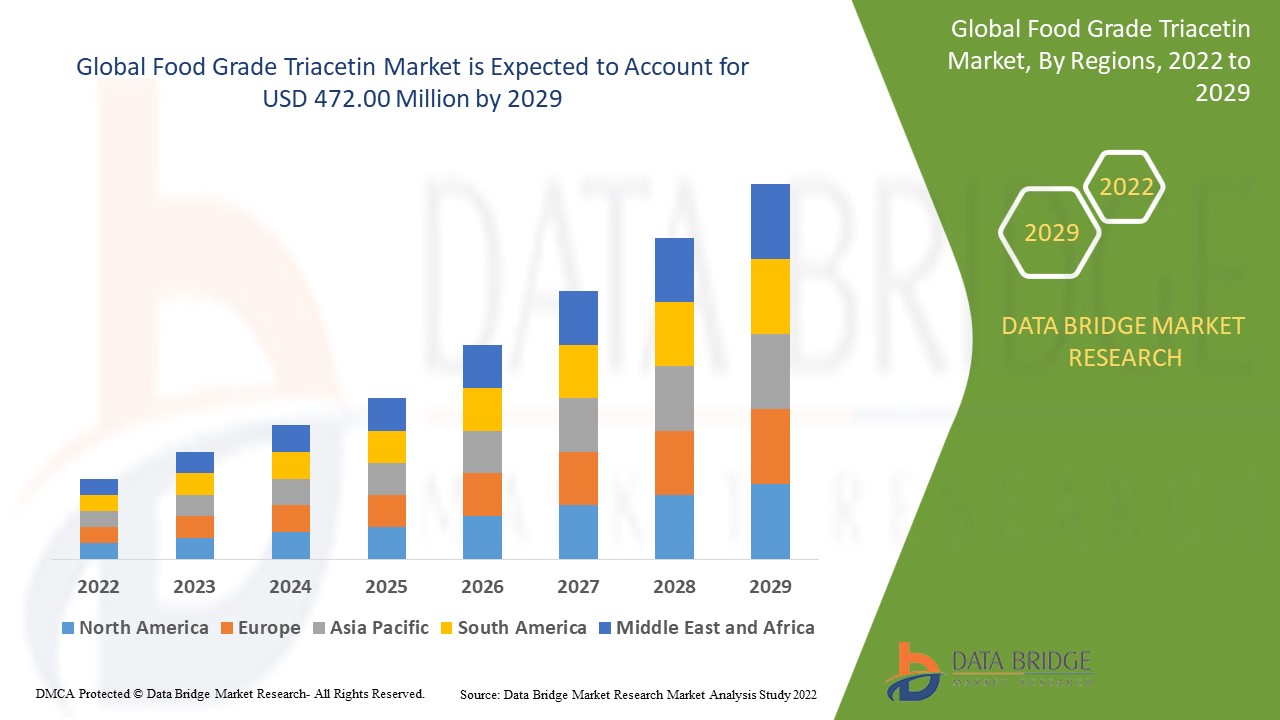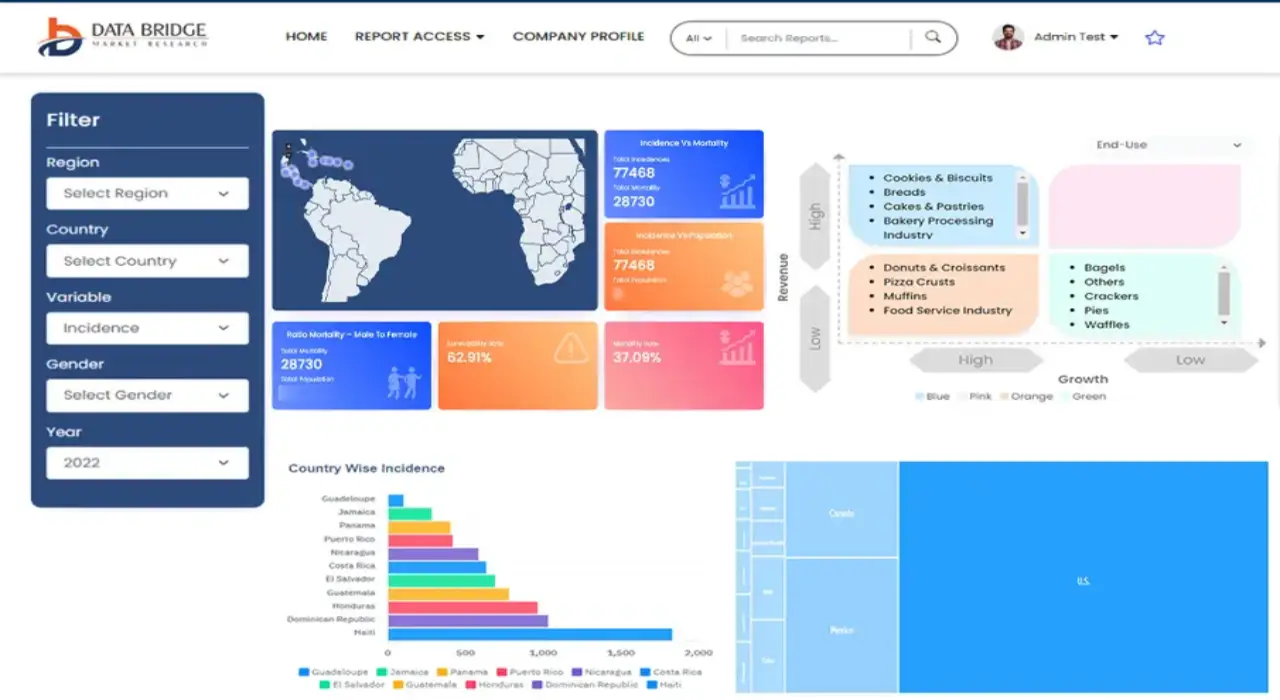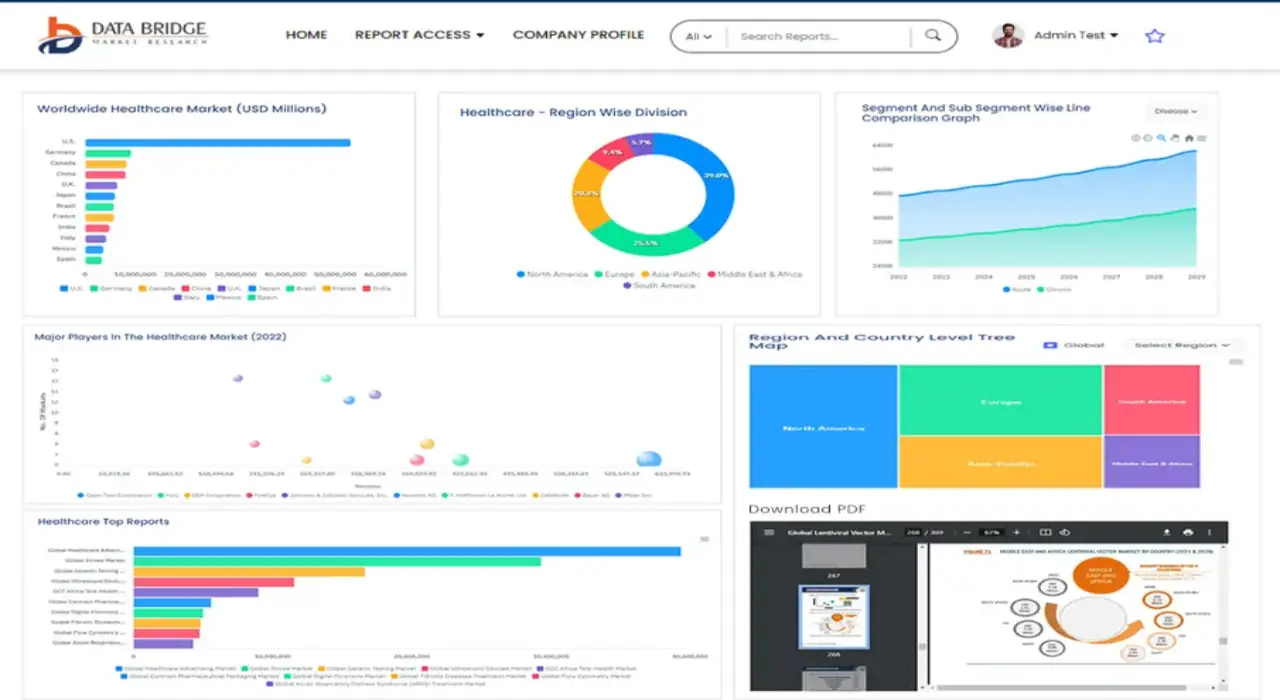Global Food Grade Triacetin Market
Tamanho do mercado em biliões de dólares
CAGR :
% 
 USD
309.90 Million
USD
472.00 Million
2021
2029
USD
309.90 Million
USD
472.00 Million
2021
2029
| 2022 –2029 | |
| USD 309.90 Million | |
| USD 472.00 Million | |
|
|
|
>Global Food Grade Triacetin Market, By Type (Plasticizer, Solvent, Humectant), Application (Tobacco, Food and Beverages, Pharmaceutical, Cosmetic and Chemical) – Industry Trends and Forecast to 2029.

Food Grade Triacetin Market Analysis and Size
Over the years, the health and wellness industry has become a dominant lifestyle value among consumers, profoundly changing consumer behaviour toward naturally sourced micronutrients. Food grade triacetin are gaining popularity in a variety of end-user industries, including cosmetics, dietary supplements, functional food and beverage and others due to its multi functionality and ongoing clean label trend.
Data Bridge Market Research analyses that the food grade triacetin market was valued at USD 309.9 million in 2021 and is expected to reach the value of USD 472.00 million by 2029, at a CAGR of 5.40% during the forecast period. In addition to the market insights such as market value, growth rate, market segments, geographical coverage, market players, and market scenario, the market report curated by the Data Bridge Market Research team includes in-depth expert analysis, import/export analysis, pricing analysis, production consumption analysis, patent analysis and consumer behaviour.
Food Grade Triacetin Market Scope and Segmentation
|
Report Metric |
Details |
|
Forecast Period |
2022 to 2029 |
|
Base Year |
2021 |
|
Historic Years |
2020 (Customizable to 2014 - 2019) |
|
Quantitative Units |
Revenue in USD Million, Volumes in Units, Pricing in USD |
|
Segments Covered |
Type (Plasticizer, Solvent, Humectant), Application (Tobacco, Food and Beverages, Pharmaceutical, Cosmetic and Chemical), |
|
Countries Covered |
U.S., Canada and Mexico in North America, Germany, Sweden, Poland, Denmark, France, U.K., Netherlands, Switzerland, Belgium, Russia, Italy, Spain, Turkey, Rest of Europe in Europe, China, Japan, India, South Korea, Singapore, Malaysia, Australia, Thailand, Indonesia, Philippines, Rest of Global (APAC) in the Global (APAC), Saudi Arabia, U.A.E, South Africa, Egypt, Israel, Rest of Middle East and Africa (MEA) as a part of Middle East and Africa (MEA), Brazil, Argentina and Rest of South America as part of South America |
|
Market Players Covered |
Eastman Chemical Company (U.S.), LANXESS (Germany), Daicel Corporation (Japan), Jiangsu Ruijia Food Ingredient Co., Ltd. (China), MOSSELMAN (Belgium), KLK OLEO (Malaysia), BASF SE (Germany) |
|
Opportunities |
|
Market Definition
A triacetin is a triestor of glycerol and acetylating agents such as acetic anhydride and acetic acid. It is also known as triglyceride and glycerine triacetate. Triacetin is a synthetic chemical compound that is primarily used as a food additive in the form of a solvent and flavourings. It acts as a plasticizer and a solvent as an excipient in pharmaceutical products. In artificial food regeneration systems, triacetin is also considered a source of food energy.
Food Grade Triacetin Market Dynamics
Drivers
- Cost effectiveness and the rise in demand for packaged food and beverages
Factors driving market growth include rising demand for packaged food and beverages, lower production costs compared to natural agents, fewer side effects on human health, and properties that extend the shelf life of food products. It is also safe to eat for both humans and animals. As a result, manufacturers prefer synthetic agents such as triacetate to natural ones. All of these factors contribute to the growth of the triacetate market.
- Increased application of triacetin due to growing application from various end user industry
Tobacco industry is increasing its demand for triacetin (tobacco grade) because of the global increase in cigarette consumption. The food and beverage, pharmaceutical, and cosmetic industries have all contributed to the triacetin market's expansion. Increased interest in triacetin in the substance industry, as a result of its compatibility with natural and synthetic rubber and light protection, is another factor expected to fuel demand and drive market growth.
Opportunity
The overall food and beverage industry's macro trend of clean label ingredients is driving the demand for natural/organic ingredients, presenting a tremendous opportunity for the food grade triacetin market to grow. Manufacturers of food and beverage products are putting a lot of effort into research and development to improve the nutritional and multifunctional profile of food items that have a lot of health benefits, which is driving the global food grade triacetin market growth.
Restraints
The main disadvantage of using triacetin is that the substance or product containing triacetin can catch fire and explode. Triacetin can cause skin burns and blindness if it comes into contact with the eyes or skin by accident. Furthermore, triacetin inhalation and ingestion are harmful to the body's vital organs. As a result, these factors are posing a challenge to the triacetin market's growth.
This food grade triacetin market report provides details of new recent developments, trade regulations, import-export analysis, production analysis, value chain optimization, market share, impact of domestic and localized market players, analyses opportunities in terms of emerging revenue pockets, changes in market regulations, strategic market growth analysis, market size, category market growths, application niches and dominance, product approvals, product launches, geographic expansions, technological innovations in the market. To gain more info on the food grade triacetin market contact Data Bridge Market Research for an Analyst Brief, our team will help you take an informed market decision to achieve market growth.
COVID-19 Impact on Food Grade Triacetin Market
The COVID-19 crisis has had a significant impact on the market. Sales of food grade triacetin have decreased significantly as a result of the majority of closures of several quick-service restaurants, hotels, and other food services. Manufacturing was severely hampered by government rules and regulations, which resulted in slow product production and impacted company inventories. As a result, the companies were unable to manufacture the products, negatively impacting the revenues of various companies.
Global Food Grade Triacetin Market Scope
The food grade triacetin market is segmented on the basis of type, and application. The growth amongst these segments will help you analyze meagre growth segments in the industries and provide the users with a valuable market overview and market insights to help them make strategic decisions for identifying core market applications.
Type
- Plasticizer
- Solvent
- Humectant
Application
- Tobacco
- Food and Beverages
- Pharmaceutical
- Cosmetic
- Chemical
Food Grade Triacetin Market Regional Analysis/Insights
The food grade triacetin market is analysed and market size insights and trends are provided by country, type, and application as referenced above.
The countries covered in the food grade triacetin market report are U.S., Canada and Mexico in North America, Germany, France, U.K., Netherlands, Switzerland, Belgium, Russia, Italy, Spain, Turkey, Rest of Europe in Europe, China, Japan, India, South Korea, Singapore, Malaysia, Australia, Thailand, Indonesia, Philippines, Rest of Asia-Pacific (APAC) in the Asia-Pacific (APAC), Saudi Arabia, U.A.E, South Africa, Egypt, Israel, Rest of Middle East and Africa (MEA) as a part of Middle East and Africa (MEA), Brazil, Argentina and Rest of South America as part of South America.
North America dominated the global food grade triacetin for food market of the total because of increased consumption of ready-to-eat food products. Asia-Pacific is expected to be an emerging market due to an increase in cigarettes smoking population rate and disposable income in this region.
The country section of the report also provides individual market impacting factors and changes in market regulation that impact the current and future trends of the market. Data points like down-stream and upstream value chain analysis, technical trends and porter's five forces analysis, case studies are some of the pointers used to forecast the market scenario for individual countries. Also, the presence and availability of global brands and their challenges faced due to large or scarce competition from local and domestic brands, impact of domestic tariffs and trade routes are considered while providing forecast analysis of the country data.
Competitive Landscape and Food Grade Triacetin Market Share Analysis
The food grade triacetin market competitive landscape provides details by competitor. Details included are company overview, company financials, revenue generated, market potential, investment in research and development, new market initiatives, global presence, production sites and facilities, production capacities, company strengths and weaknesses, product launch, product width and breadth, application dominance. The above data points provided are only related to the companies' focus related to Food Grade Triacetin market.
Some of the major players operating in the food grade triacetin market are:
- Eastman Chemical Company (U.S.)
- LANXESS (Germany
- Daicel Corporation (Japan)
- Jiangsu Ruijia Food Ingredient Co., Ltd. (China)
- MOSSELMAN (Belgium)
- KLK OLEO (Malaysia)
- BASF SE (Germany)
SKU-
Obtenha acesso online ao relatório sobre a primeira nuvem de inteligência de mercado do mundo
- Painel interativo de análise de dados
- Painel de análise da empresa para oportunidades de elevado potencial de crescimento
- Acesso de analista de pesquisa para personalização e customização. consultas
- Análise da concorrência com painel interativo
- Últimas notícias, atualizações e atualizações Análise de tendências
- Aproveite o poder da análise de benchmark para um rastreio abrangente da concorrência
Metodologia de Investigação
A recolha de dados e a análise do ano base são feitas através de módulos de recolha de dados com amostras grandes. A etapa inclui a obtenção de informações de mercado ou dados relacionados através de diversas fontes e estratégias. Inclui examinar e planear antecipadamente todos os dados adquiridos no passado. Da mesma forma, envolve o exame de inconsistências de informação observadas em diferentes fontes de informação. Os dados de mercado são analisados e estimados utilizando modelos estatísticos e coerentes de mercado. Além disso, a análise da quota de mercado e a análise das principais tendências são os principais fatores de sucesso no relatório de mercado. Para saber mais, solicite uma chamada de analista ou abra a sua consulta.
A principal metodologia de investigação utilizada pela equipa de investigação do DBMR é a triangulação de dados que envolve a mineração de dados, a análise do impacto das variáveis de dados no mercado e a validação primária (especialista do setor). Os modelos de dados incluem grelha de posicionamento de fornecedores, análise da linha de tempo do mercado, visão geral e guia de mercado, grelha de posicionamento da empresa, análise de patentes, análise de preços, análise da quota de mercado da empresa, normas de medição, análise global versus regional e de participação dos fornecedores. Para saber mais sobre a metodologia de investigação, faça uma consulta para falar com os nossos especialistas do setor.
Personalização disponível
A Data Bridge Market Research é líder em investigação formativa avançada. Orgulhamo-nos de servir os nossos clientes novos e existentes com dados e análises que correspondem e atendem aos seus objetivos. O relatório pode ser personalizado para incluir análise de tendências de preços de marcas-alvo, compreensão do mercado para países adicionais (solicite a lista de países), dados de resultados de ensaios clínicos, revisão de literatura, mercado remodelado e análise de base de produtos . A análise de mercado dos concorrentes-alvo pode ser analisada desde análises baseadas em tecnologia até estratégias de carteira de mercado. Podemos adicionar quantos concorrentes necessitar de dados no formato e estilo de dados que procura. A nossa equipa de analistas também pode fornecer dados em tabelas dinâmicas de ficheiros Excel em bruto (livro de factos) ou pode ajudá-lo a criar apresentações a partir dos conjuntos de dados disponíveis no relatório.














